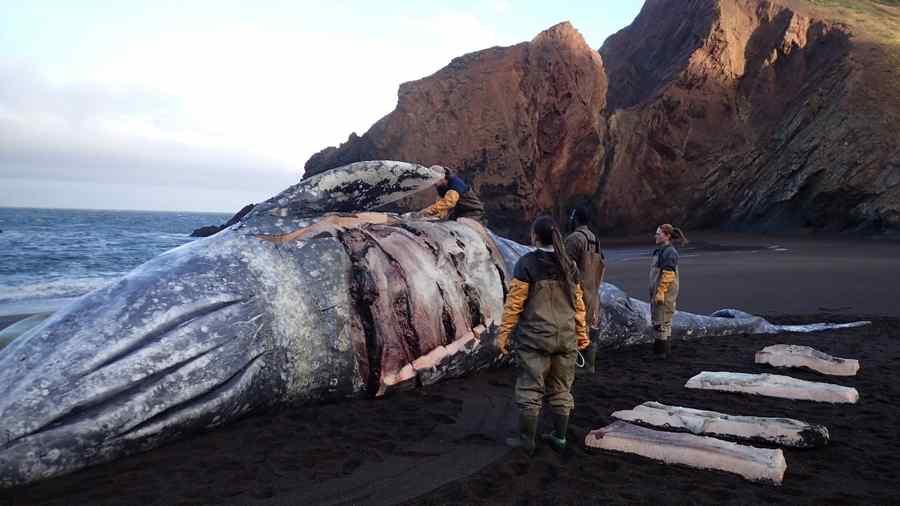
The whale at the west end of Bolinas Beach is believed to be a female fin whale, but a necropsy has yet to be conducted. That will occur in the coming days, officials said.
A whale found Friday on Tennessee Valley Beach, and a second taken to Angel Island for a necropsy on the same day, both died because of human interactions, Marine Mammal Center officials said Wednesday.
Severe entanglement with fishing gear was confirmed as the cause of death for a 36-foot adult female gray whale that washed ashore on the Marin beach. The Angel Island necropsy results of a 45-foot juvenile female fin whale — found initially offshore of Alameda County and then towed to the island — showed it died due to a vessel collision.
"The deaths of these two whales highlights the direct negative impact humans can have on marine wildlife," said Dr. Shawn Johnson, director of veterinary science at the Marine Mammal Center.
Coincidentally Wednesday, the National Oceanic and Atmospheric Administration released a report on whale entanglements from 2017, with 31 being reported off the West Coast.
"The number of confirmed entanglements in 2017 was lower than the historic highs of (50 in 2015) and (48 in 2016), but still represents a significant increase compared to pre-2014 levels when the average was less than 10 confirmed entanglements per year," the report reads.
"California fishery managers have failed to meaningfully address the problem of whale entanglements," said Catherine Kilduff of the Oakland-based Center for Biological Diversity. "Too many whales are still being killed and injured in crab lines."
The whale seen on Bolinas Beach is the latest in a string of the dead animals. In early February, a 26-foot juvenile female gray whale underwent a necropsy on Angel Island. The animal's fluke was missing and completely severed. On closer inspection, copper wiring strands wrapped in white plastic were found, consistent with entanglement. The mammal center's scientists also discovered numerous rake marks and multiple rib fractures on the whale's left side, consistent with an orca attack.
In March, a 28-foot juvenile male gray whale was examined on the island. It likely died of malnutrition, according to the mammal center. On May 8, a 44-foot adult female gray whale washed up at Oakland Airport and was towed to Angel Island for necropsy. Death from a ship strike was the preliminary assessment.
"Frankly we don't know why we are seeing all these cases, but it does illustrate the human factor," said Mary Jane Schramm, spokeswoman for the Greater Farallones National Marine Sanctuary.
When it comes to human impacts, ship strikes are a leading cause of whale deaths. Far more whales die in collisions with ships off the West Coast than wash up on beaches because they sink at sea, a 2017 Point Blue Conservation Science study found.
"The whale autopsy work the center and its partners perform is critical to better understand the challenges these animals face and inform decision-makers so we can all safely share the ocean with marine wildlife," Johnson said.



Reader Comments
to our Newsletter